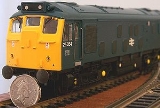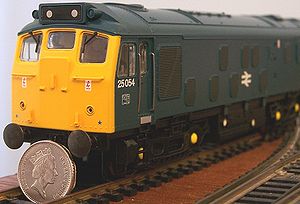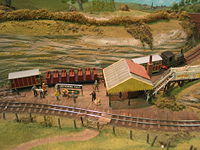
4mm scale
Encyclopedia
4 mm scale is the most popular model railway scale
used in the United Kingdom
. The term refers to the use of 4 millimeters on the model equating to a distance of 1 foot (305 mm) on the prototype (1:76.2). It is also used for military modelling.
For historical reasons, a number of different standards are employed.
 Three different gauges are used for modelling standard gauge
Three different gauges are used for modelling standard gauge
railways in the United Kingdom
.
uses 4 mm scale with 16.5 mm gauge
track, which is inaccurately narrow since it is correct for HO scale
(1:87.1). It is the most popular standard in the UK for 4 mm scale trains and is produced by the two main manufacturers in the UK. The traditional standard for wheels and track is a very coarse one with extremely oversize rail
s and flange
s; in recent years, some manufacturers have switched to using the American National Model Railroad Association
HO standard S-4 instead.
was originally defined to use 18mm as the track gauge (hence the name), this was revised, and today EM gauge uses an 18.2mm track gauge, which is closer to accurate but not fully to scale. It was developed as an early improvement on the standard OO system. It is still popular with FineScale modellers today because it utilises larger than scale flanges on the wheels of rolling stock, and because point and crossing (P&C) work is a little easier due to an overscale flangeway clearance. These two concessions in scaling down the prototype make for reliable running. This factor explains the continued popularity of EM as a scale for finescale modellers working today.
is a close to exact 4 mm:1 ft (305 mm) replica of real-life track and wheel dimensions. The gauge of track built to these standards is 18.83mm. Along with EM Gauge It is also a popular choice for finescale modellers working today. The main advantage of P4 over the other 4mm standards is that the wheel flanges are approximately to scale and the flangway gaps on P&C work are also close to scale. This is most noticeable in photographs of the model where in many cases is it almost impossible to detect that you are looking at a model, as opposed to the real thing. The disadvantages of near to scale flanges and flangeway crossings are that the trackwork has to be laid and built to very close tolerances and needs to be flat. If this is not the case then the reliability of rolling stock on the trackwork is compromised leading to poor running and derailments. This problem can, to an extent, be mitigated by the used of a suspension system in the locomotives and by the use of 3 point suspension system in the rolling stock used on the layout.
is 5' 3". OO
models are available from Bachmann
and have previously been available from Lima
. P4 standards
can also used with a track gauge of 21mm.
Narrow gauge

OOn3
12 mm gauge (TT gauge) track used to model 3 foot (914 mm) prototypes which were common in Ireland
and the Isle of Man
.
Rail transport modelling scales
Rail transport modelling utilises a variety of scales to ensure scale models look correct when placed next to each other. Model railway scales are standardized worldwide by many organizations and hobbyist groups...
used in the United Kingdom
United Kingdom
The United Kingdom of Great Britain and Northern IrelandIn the United Kingdom and Dependencies, other languages have been officially recognised as legitimate autochthonous languages under the European Charter for Regional or Minority Languages...
. The term refers to the use of 4 millimeters on the model equating to a distance of 1 foot (305 mm) on the prototype (1:76.2). It is also used for military modelling.
For historical reasons, a number of different standards are employed.
Standard gauge

Standard gauge
The standard gauge is a widely-used track gauge . Approximately 60% of the world's existing railway lines are built to this gauge...
railways in the United Kingdom
United Kingdom
The United Kingdom of Great Britain and Northern IrelandIn the United Kingdom and Dependencies, other languages have been officially recognised as legitimate autochthonous languages under the European Charter for Regional or Minority Languages...
.
OO gauge
OO gaugeOO gauge
OO gauge or OO scale model railways are the most popular standard-gauge model railway tracks in the U.K. This track gauge is one of several 4mm-scale standards used, but it is the only one to be served by the major manufacturers...
uses 4 mm scale with 16.5 mm gauge
Rail gauge
Track gauge or rail gauge is the distance between the inner sides of the heads of the two load bearing rails that make up a single railway line. Sixty percent of the world's railways use a standard gauge of . Wider gauges are called broad gauge; smaller gauges, narrow gauge. Break-of-gauge refers...
track, which is inaccurately narrow since it is correct for HO scale
HO scale
HO or H0 is the most popular scale of model railway in the world.According to the NMRA standard S-1.2 predominantly used in North America, in HO scale, represents 1 real foot ; this ratio works out to about 1:87.1. According to the MOROP standard NEM 010 predominantly used in Europe, the scale is...
(1:87.1). It is the most popular standard in the UK for 4 mm scale trains and is produced by the two main manufacturers in the UK. The traditional standard for wheels and track is a very coarse one with extremely oversize rail
Rail tracks
The track on a railway or railroad, also known as the permanent way, is the structure consisting of the rails, fasteners, sleepers and ballast , plus the underlying subgrade...
s and flange
Flange
A flange is an external or internal ridge, or rim , for strength, as the flange of an iron beam such as an I-beam or a T-beam; or for attachment to another object, as the flange on the end of a pipe, steam cylinder, etc., or on the lens mount of a camera; or for a flange of a rail car or tram wheel...
s; in recent years, some manufacturers have switched to using the American National Model Railroad Association
National Model Railroad Association
The National Model Railroad Association is a non-profit organization for those involved in the hobby or business of model railroading. It was founded in the United States in 1935, and is now active in Canada, Australia, Great Britain, and the Netherlands...
HO standard S-4 instead.
EM gauge
EMEM gauge
EM gauge is a variant of 4 mm to a foot scale used in model railways....
was originally defined to use 18mm as the track gauge (hence the name), this was revised, and today EM gauge uses an 18.2mm track gauge, which is closer to accurate but not fully to scale. It was developed as an early improvement on the standard OO system. It is still popular with FineScale modellers today because it utilises larger than scale flanges on the wheels of rolling stock, and because point and crossing (P&C) work is a little easier due to an overscale flangeway clearance. These two concessions in scaling down the prototype make for reliable running. This factor explains the continued popularity of EM as a scale for finescale modellers working today.
P4 gauge
P4P4 gauge
P4 or Protofour is a set of standards for model railways allowing a more accurate construction of models to a scale of 4 mm to 1 foot , the predominant scale of model railways of the British prototype...
is a close to exact 4 mm:1 ft (305 mm) replica of real-life track and wheel dimensions. The gauge of track built to these standards is 18.83mm. Along with EM Gauge It is also a popular choice for finescale modellers working today. The main advantage of P4 over the other 4mm standards is that the wheel flanges are approximately to scale and the flangway gaps on P&C work are also close to scale. This is most noticeable in photographs of the model where in many cases is it almost impossible to detect that you are looking at a model, as opposed to the real thing. The disadvantages of near to scale flanges and flangeway crossings are that the trackwork has to be laid and built to very close tolerances and needs to be flat. If this is not the case then the reliability of rolling stock on the trackwork is compromised leading to poor running and derailments. This problem can, to an extent, be mitigated by the used of a suspension system in the locomotives and by the use of 3 point suspension system in the rolling stock used on the layout.
Conversion to EM and P4
00 models can be converted to work on EM or P4 by replacing or reprofiling wheels, fitting the correct width axles and moving the locomotive or carriage frames outward to suit. Modern products from Hornby, Bachmann UK and others have some element of springing in their suspension to aid this, and many aftermarket chassis kits exist from a variety of vendors such as high level kits, Comet, DJH, and others. Products intended for the more dedicated modeller are generally designed to be buildable to fit any of the three standards, though one side effect of underscale locomotive frames for 00 gauge is that the width between the frames is limited, which can limit the size of electric motor that may be fitted.Irish Broad Gauge
Irish Broad GaugeRail gauge in Ireland
The track gauge adopted by the mainline railways in Ireland is . This unusual gauge is currently otherwise found only in the Australian states of Victoria, southern New South Wales and South Australia , and in Brazil...
is 5' 3". OO
OO gauge
OO gauge or OO scale model railways are the most popular standard-gauge model railway tracks in the U.K. This track gauge is one of several 4mm-scale standards used, but it is the only one to be served by the major manufacturers...
models are available from Bachmann
Bachmann Branchline
Bachmann Branchline is a brand name of Bachmann Industries used for British outline 00 gauge model railways.Bachmann, a US company founded in 1835, was purchased by Kader Industries in 1987. Kader had previously produced models for Palitoy under the 'Mainline' brand...
and have previously been available from Lima
Lima (models)
Lima S.p.A was a brand of railway models made in Vicenza, Italy, for almost 50 years, from the early 1950s until the company ceased trading in 2004...
. P4 standards
P4 gauge
P4 or Protofour is a set of standards for model railways allowing a more accurate construction of models to a scale of 4 mm to 1 foot , the predominant scale of model railways of the British prototype...
can also used with a track gauge of 21mm.
Narrow gaugeNarrow gaugeA narrow gauge railway is a railway that has a track gauge narrower than the of standard gauge railways. Most existing narrow gauge railways have gauges of between and .- Overview :...

OOn3OOn3OOn3 is a model railway standard for modelling narrow gauge railways in 4mm scale scale with gauge track. prototypes were common in Ireland and the Isle of Man, but the scale is not generally used outside the British Isles. gauge track is the same as that used in TT scale and HOm, so some...
12 mm gauge (TT gauge) track used to model 3 foot (914 mm) prototypes which were common in IrelandIreland
Ireland is an island to the northwest of continental Europe. It is the third-largest island in Europe and the twentieth-largest island on Earth...
and the Isle of Man
Isle of Man
The Isle of Man , otherwise known simply as Mann , is a self-governing British Crown Dependency, located in the Irish Sea between the islands of Great Britain and Ireland, within the British Isles. The head of state is Queen Elizabeth II, who holds the title of Lord of Mann. The Lord of Mann is...
.
External links
- The Double 0 Gauge Association, supports 4mm modelling using a 16.5mm gauge
- EM Gauge Society, supports modelling in both EM (18.2 gauge) and P4 (18.83 gauge)
- The Scalefour Society, supporting modelling in P4
- Diesel and Electric Modellers United, promoting and supporting the modelling of the Diesel and Electric era of the British standard gauge railway system
- The 009 Society - Supporting modelling 4mm narrow gauge modelling

